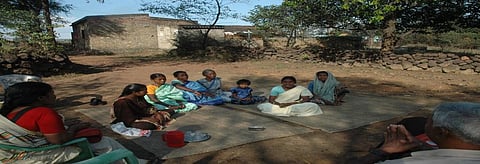

In a move that can improve the lives of families directly affected by mining, district authorities of Korba, Chhattisgarh’s coal and thermal power hub, have initiated a resource-based plan that can ensure sustainable income for hundreds.
This could be the first district in the country to initiate a targeted resource and need-based livelihood plan through the District Mineral Foundation (DMF), and can set a precedent for other mining-affected districts if implemented well.
In a circular dated September 12, 2018, the district authorities sought a proposal from external agencies, particularly non-profits to implement a livelihood model for villages identified as directly-affected by mining. Lakhtakiya or the one lakh rupees model is based on money spent per family and is likely to be targeted towards “directly-affected” households, which include 202 villages within three kilometers of the mines. The proposed initiative will be 18-months long.
DMF is a non-profit trust set under the Mines and Minerals (Development and Regulation) Act, 2015 to “work for the interest and benefit of persons, and areas affected by mining.” The mining companies pay a defined proportion of the royalty to DMF as a way of sharing profits with those whose land is being mined upon.
So far, Korba district has a DMF corpus of about Rs. 700 crore and will be getting an estimated Rs. 250 crore every year. However, in the past three years, the focus of the district’s DMF investments has been on construction (roads, bridges and education infrastructure), according to previous analysis by the Delhi-based non-profit Centre for Science and Environment (CSE). Skill development got just 1.3 per cent investment from the district’s DMF until March 2018. There had been no focus on livelihood creation based on local resources through DMF until now.
Target households – economically and socially disadvantaged
About 200 marginalised families will be identified within the 202 directly-affected villages. A multi-livelihood option plan will be created on the basis of a resource mapping of the households to suit the needs, resources and skills of the families. “The livelihood options could be based on agriculture, Natural Resource Management, animal husbandry, Non Timber Forest Produce (NTFP) or any other option which can enhance the income and also ensure regularity of income on long-term basis,” says the circular.
The district proposes to spend Rs 1 lakh per unit, or family for expenditures like capacity building, training, exposure, procurement of materials, construction support, seed money, subject to the needs of the family.
Families headed by women, those falling below poverty line (BPL), landless and marginal farmers, disabled, and families with single or no livelihood options will be targeted. The target of the initiative is to double the household income of the families and ensure they move out of the Above Poverty Line (APL) category.
The district will incur an expense of just Rs. 2 crore for the ground implementation of the project. District officials the author spoke to said they are aiming to successfully implement it and replicate it in different areas to harness the local resource potential.
Implementation is key
Korba has one of the worst work participation rates in Chhattisgarh with only 43.2 per cent working population, according to the Census 2011. Income stability is also a big concern. In about 91 per cent rural households in Korba, the highest earning member earns less than Rs. 5,000 per month, says the Socio-Economic Caste Census (SECC), 2011. About 80 per cent are marginal farmers as per the district’s estimates.
Locals say that unemployment and underemployment is acute in mining areas, where people subsist on manual and unskilled labour. “Another issue is dependence on mines which are not only hazardous but also not a sustainable source of income for unskilled labourers. People are doing small jobs and once the mine shuts, those also would not be left,” said Lakshmi Chouhan, a local who has been working on land acquisition and mining related issues in the region.
If implemented well, the initiative can not only lead to sustained livelihood generation, but also set a precedent for other districts to follow, adds Chouhan. "Many big mining districts like Korba are rich in forests and DMFs can be used for NTFPs, which will link people to the local resources and for
creation of market linkages,” says Srestha Banerjee, Programme Manager, Environmental Governance Unit, CSE.